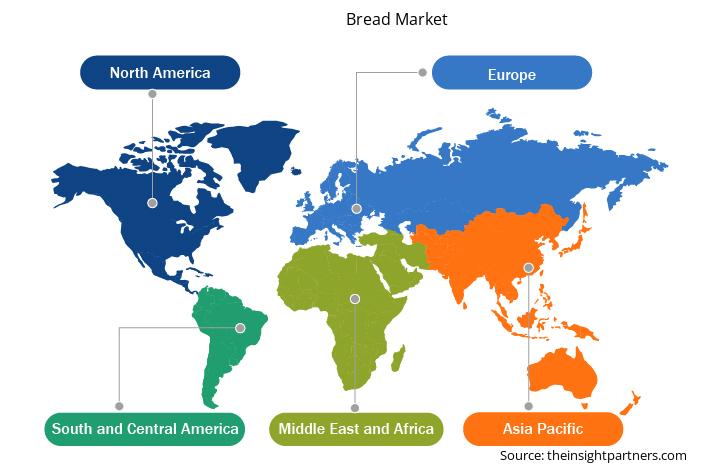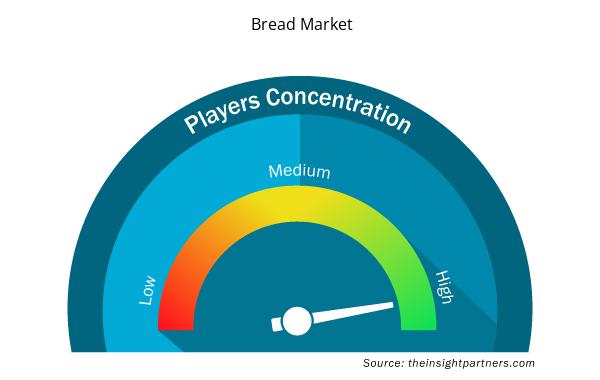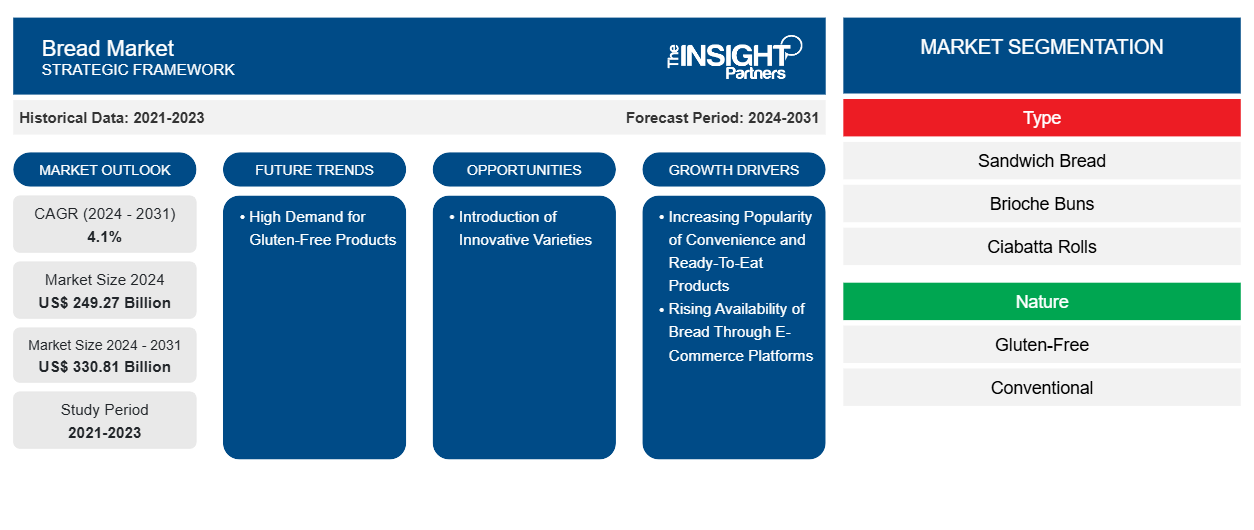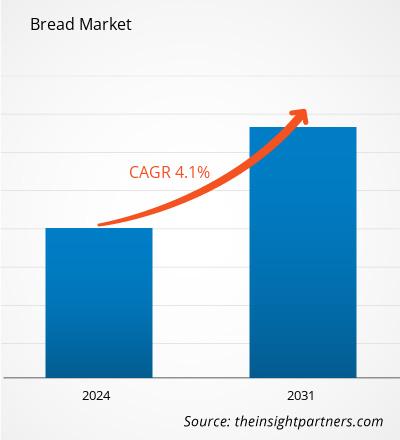Si prevede che il mercato del pane raggiungerà i 330,81 miliardi di dollari entro il 2031, rispetto ai 249,27 miliardi di dollari del 2024. Si prevede che il mercato registrerà un CAGR del 4,1% nel periodo 2024-2031. È probabile che la crescente popolarità dei prodotti senza glutine porti nuove tendenze nel mercato durante il periodo di previsione.
Analisi del mercato del pane
Le aziende del mercato del pane in tutto il mondo stanno riscontrando un'impennata della domanda dovuta alla crescente preferenza per prodotti pronti e pratici. Stili di vita prevalentemente frenetici, insieme alla necessità di soluzioni per pasti veloci e semplificate, hanno portato a un aumento significativo del consumo di pane in tutto il mondo. I consumatori selezionano prodotti di pane senza glutine, a basso contenuto di carboidrati, ad alto contenuto di fibre o integrali in base alle specifiche degli ingredienti fornite sulle etichette. Le mutevoli priorità dei consumatori e la crescente preferenza per alternative più sane hanno portato alla domanda di pane biologico, baguette, bagel, panini e panini. In risposta, i produttori di pane stanno anche innovando ampiamente i loro prodotti, offrendo pane artigianale, pane funzionale e pane fortificato incorporando ingredienti funzionali come semi, noci, cereali antichi, verdure e diverse vitamine e minerali. Pertanto, le mutevoli esigenze dei consumatori in termini di gusto hanno portato a un'elevata domanda di pane speciale e funzionale, che dovrebbe offrire opportunità redditizie ai produttori di pane.
Panoramica del mercato del pane
Il pane è un alimento base apprezzato in tutto il mondo. Ha una ricca storia che abbraccia migliaia di anni ed è stato una parte integrante delle tradizioni culinarie di diverse culture. Dal pane a fette alle baguette e ai bagel, ogni regione ha varietà di pane uniche che riflettono i sapori e le usanze locali. È fatto da un impasto preparato con farina (grano, orzo, avena, segale e altre farine), lievito e zucchero, spesso tramite cottura. È stato un alimento importante in vaste parti del mondo. È uno dei più antichi prodotti da forno fabbricati e ha avuto un'importanza considerevole sin dall'inizio dell'agricoltura. È stato anche determinante nella ricreazione di una parte essenziale delle cerimonie religiose e della cultura quotidiana. È un prodotto alimentare normale nelle case, nei ristoranti e nei bar; inoltre, è anche comunemente incorporato in ricette come panini e panini. La classe crescente di professionisti, gli orari di lavoro frenetici e gli stili di vita frenetici determinano una domanda considerevole di prodotti alimentari comodi e pronti al consumo, tra cui il pane, che può essere consumato a colazione, come spuntino o come pasto con meno requisiti di preparazione. Inoltre, si prevede che la crescente urbanizzazione e la crescente influenza della cucina occidentale genereranno opportunità redditizie per la crescita del mercato del pane in tutto il mondo durante il periodo di previsione.
Personalizza questo report in base alle tue esigenze
Riceverai la personalizzazione gratuita di qualsiasi report, comprese parti di questo report, o analisi a livello nazionale, pacchetto dati Excel, oltre a usufruire di grandi offerte e sconti per start-up e università
- Scopri le principali tendenze di mercato in questo rapporto.Questo campione GRATUITO includerà analisi di dati che spaziano dalle tendenze di mercato alle stime e alle previsioni.
Driver e opportunità del mercato del pane
La crescente disponibilità di pane attraverso le piattaforme di e-commerce alimenta la crescita del mercato
Poiché i consumatori si stanno spostando sempre più verso lo shopping online per comodità, il mercato del pane è pronto a beneficiare di una maggiore visibilità e di una più ampia disponibilità di prodotti. I canali di e-commerce offrono ai consumatori la comodità di ordinare prodotti da forno comodamente da casa. I consumatori possono sfogliare un'ampia varietà di pane, confrontare i prezzi e scegliere i prodotti dei marchi di fiducia consultando le istruzioni sulle etichette e le recensioni di altri consumatori prima di effettuare gli ordini. Questo aspetto pratico dell'e-commerce è particolarmente attraente per le persone impegnate o per coloro che potrebbero non avere facile accesso ai negozi di alimentari fisici. Secondo Agriculture Canada, negli Stati Uniti, le vendite di e-commerce di generi alimentari sono cresciute del 26,4% all'anno dal 2019 al 2023. Inoltre, secondo Ecommerce Europe, il fatturato totale dell'e-commerce europeo B2C ha registrato una modesta crescita del 3% nel 2023, registrando un aumento da 864 miliardi di euro a 887 miliardi di euro. Le piattaforme di e-commerce forniscono ai produttori di pane un canale diretto per raggiungere i consumatori in tutto il mondo. Sfruttando le piattaforme di e-commerce, i produttori di pane possono superare le barriere tradizionali come le limitazioni geografiche e le sfide della distribuzione e attingere a nuovi mercati oltre le loro regioni locali. Inoltre, queste piattaforme offrono loro la flessibilità di mostrare i loro prodotti e comunicare direttamente con i consumatori, migliorando di conseguenza la visibilità del marchio e il coinvolgimento dei clienti.
Inoltre, aggirando gli intermediari e i canali di vendita al dettaglio tradizionali, i produttori di prodotti da forno possono comprendere meglio le preferenze dei consumatori, ricevere feedback e adattare di conseguenza le loro offerte. Pertanto, i principali attori come Grupo Bimbo SAB de CV, Dr Schar AG, Dimpflmeier Bakery Ltd, Campbell Soup Co. e Wonder Brands Inc. che operano nel mercato stanno catalizzando la loro attività distribuendo i loro prodotti da forno tramite piattaforme di e-commerce, il che, a sua volta, rafforza la crescita del mercato globale del pane.
Introduzione di varietà innovative per creare opportunità di crescita nel mercato
I consumatori selezionano prodotti di pane senza glutine, a basso contenuto di carboidrati, ad alto contenuto di fibre o integrali in base alle specifiche degli ingredienti fornite sulle etichette. Le mutevoli priorità dei consumatori e la crescente preferenza per alternative più sane hanno portato alla domanda di pane biologico, baguette, bagel, panini e panini. In risposta, anche i produttori di pane stanno innovando ampiamente i loro prodotti, offrendo pane artigianale, pane funzionale e pane fortificato incorporando ingredienti funzionali come semi, noci, cereali antichi, verdure e diverse vitamine e minerali. Alcuni fornai creano anche pani e pagnotte tradizionali utilizzando una combinazione insolita di ingredienti come carote, barbabietole, spinaci e altre verdure. Inoltre, cumino, curcuma e cannella stanno guadagnando riconoscimento come ingredienti speciali per sperimentare con i sapori. Sara Lee, un marchio dei produttori di pane Grupo Bimbo SAB de CV, ha annunciato "White Bread Made with Veggies" a gennaio 2023 come ultima aggiunta al suo portafoglio di prodotti. Cotto con l'equivalente di una tazza di verdure per pagnotta, il prodotto appena lanciato è arricchito con vitamina A, D ed E, evidenziando modi pratici per aggiungere alcuni nutrienti extra a qualsiasi pasto. A maggio 2024, Bimbo Bakeries USA, una sussidiaria di Grupo Bimbo SAB de CV, ha lanciato pane e panini da forno hawaiani nel suo portafoglio Sara Lee Artesano. I due nuovi prodotti di pane offrono pane e panini deliziosi e dolci con il perfetto tocco tropicale senza aromi artificiali, conservanti o sciroppo di mais ad alto contenuto di fruttosio. Nature's Harvest (un marchio di Grupo Bimbo SAB de CV) ha annunciato il rilancio della sua linea completa di prodotti di panetteria in California (USA) a giugno 2022. Il rilancio aveva lo scopo di introdurre due nuove varietà nel suo portafoglio "Butter and White made with Whole Grain", che presentava un packaging aggiornato con un aspetto e una sensazione rinnovati. La reintroduzione ha comportato miglioramenti basati sulle intuizioni dei consumatori per le varietà, il gusto e il packaging di Nature's Harvest. Con questa mossa, il marchio ha sottolineato il suo impegno nel produrre ogni pagnotta localmente, in California.
Analisi della segmentazione del rapporto sul mercato del pane
I segmenti chiave che hanno contribuito alla derivazione dell'analisi del mercato del pane sono tipo, natura, categoria e applicazione.
- Per tipologia, il mercato del pane è segmentato in pane da sandwich, panini brioche, panini ciabatta, baguette, panini e focacce, panini per hamburger, panini per hotdog e altri. Il segmento del pane da sandwich ha detenuto la quota maggiore del mercato nel 2024.
- In base alla natura, il mercato è diviso in senza glutine e convenzionale. Il segmento convenzionale ha dominato il mercato nel 2024.
- In base alla categoria, il mercato è segmentato in congelato e a temperatura ambiente e refrigerato. Il segmento a temperatura ambiente e refrigerato ha detenuto una quota di mercato maggiore nel 2024.
- In termini di utilizzo finale, il mercato è segmentato in vendita al dettaglio e ristorazione. Il segmento della vendita al dettaglio deteneva una quota maggiore del mercato nel 2024.
Analisi della quota di mercato del pane per area geografica
L'ambito geografico del rapporto sul mercato del pane è suddiviso in cinque regioni: Nord America, Asia Pacifico, Europa, Medio Oriente e Africa e Sud e Centro America. Si prevede che il mercato del pane nell'Asia Pacifico crescerà in modo significativo durante il periodo di previsione.
Il settore della panetteria nell'area Asia-Pacifico ha registrato una crescita significativa grazie al crescente consumo in India, Giappone e Cina, tra gli altri paesi. La domanda di diversi tipi di pane sta aumentando nella regione a causa della crescente preferenza dei consumatori per prodotti alimentari comodi e pronti al consumo, in particolare prodotti da forno (pane, baguette, panini e panini), insieme a un aumento dell'attrattiva delle diete occidentali. In mezzo alla continua urbanizzazione, gli stili di vita stanno diventando sempre più frenetici nella regione, il che spinge i consumatori verso opzioni di pasti veloci e convenienti, rendendo il pane una scelta allettante. Oltre a questo, la crescente consapevolezza riguardo alla salute e al benessere spinge i consumatori a cercare opzioni di pane più sane, come varietà integrali, multicereali e senza glutine che offrono benefici nutrizionali. Pertanto, i consumatori nella regione stanno sempre più optando per prodotti alimentari a base di miglio nei loro pasti. Per soddisfare la domanda di prodotti da forno a base di miglio, i marchi di panetteria che operano nell'area Asia-Pacifico stanno lanciando sempre più nuovi prodotti. Tuttavia, le abitudini alimentari tradizionali e le preferenze culturali sono prevalenti in India, Cina, Corea del Sud e altri paesi asiatici; di conseguenza, le persone in questi paesi danno la priorità a riso, grano, miglio, legumi, latticini, verdure, frutta, pasta e altri alimenti di base rispetto al pane, il che limita il mercato in questa regione.
Approfondimenti regionali sul mercato del pane
Le tendenze regionali e i fattori che influenzano il Bread Market durante il periodo di previsione sono stati ampiamente spiegati dagli analisti di Insight Partners. Questa sezione discute anche i segmenti e la geografia del Bread Market in Nord America, Europa, Asia Pacifico, Medio Oriente e Africa, e Sud e Centro America.

- Ottieni i dati specifici regionali per il mercato del pane
Ambito del rapporto sul mercato del pane
| Attributo del report | Dettagli |
|---|---|
| Dimensioni del mercato nel 2024 | 249,27 miliardi di dollari USA |
| Dimensioni del mercato entro il 2031 | 330,81 miliardi di dollari USA |
| CAGR globale (2024 - 2031) | 4,1% |
| Dati storici | 2021-2023 |
| Periodo di previsione | 2024-2031 |
| Segmenti coperti | Per tipo
|
| Regioni e Paesi coperti | America del Nord
|
| Leader di mercato e profili aziendali chiave |
|
Densità degli attori del mercato del pane: comprendere il suo impatto sulle dinamiche aziendali
Il mercato del pane sta crescendo rapidamente, spinto dalla crescente domanda degli utenti finali dovuta a fattori quali l'evoluzione delle preferenze dei consumatori, i progressi tecnologici e una maggiore consapevolezza dei benefici del prodotto. Con l'aumento della domanda, le aziende stanno ampliando le loro offerte, innovando per soddisfare le esigenze dei consumatori e capitalizzando sulle tendenze emergenti, il che alimenta ulteriormente la crescita del mercato.
La densità degli operatori di mercato si riferisce alla distribuzione di aziende o società che operano in un particolare mercato o settore. Indica quanti concorrenti (operatori di mercato) sono presenti in un dato spazio di mercato in relazione alle sue dimensioni o al valore di mercato totale.
Le principali aziende che operano nel mercato del pane sono:
- Lantmann Unibake
- Prodotti Rich Corp.
- Panificio La Brea
- Fiori Foods Inc
- Gruppo Bimbo SAB di CV
Disclaimer : le aziende elencate sopra non sono classificate secondo un ordine particolare.

- Ottieni una panoramica dei principali attori del mercato del pane
Notizie e sviluppi recenti sul mercato del pane
Il mercato del pane viene valutato raccogliendo dati qualitativi e quantitativi dopo la ricerca primaria e secondaria, che include importanti pubblicazioni aziendali, dati associativi e database. Ecco alcuni degli sviluppi chiave nel mercato del pane:
- Ad aprile 2023, Britannia, un marchio del Bonn Group, ha lanciato "Millet Bread", senza Maida, per i consumatori indiani. Questo prodotto a base di pane è incorporato con ragi, jowar, bajra e avena e contiene notevoli quantità di fibre e minerali che offrono ai consumatori un modo pratico per includere opzioni a base di miglio nei loro pasti. (Fonte: Britannia, sito Web aziendale, aprile 2024)
- Lantmännen Unibake Sweden ha rilanciato una serie di panini per hamburger e panini per hotdog con più cereali integrali e fibre. L'obiettivo è rendere più interessante per i consumatori svedesi scegliere alternative più sane ai prodotti fast-food convenzionali. (Fonte: Lantmännen Unibake Sweden, comunicato stampa, aprile 2024)
Copertura e risultati del rapporto sul mercato del pane
Il rapporto "Dimensioni e previsioni del mercato del pane (2021-2031)" fornisce un'analisi dettagliata del mercato che copre le seguenti aree:
- Dimensioni e previsioni del mercato del pane a livello globale, regionale e nazionale per tutti i segmenti di mercato chiave coperti dall'ambito
- Tendenze del mercato del pane, nonché dinamiche di mercato come fattori trainanti, vincoli e opportunità chiave
- Analisi dettagliata delle cinque forze di Porter e SWOT
- Analisi del mercato del pane che copre le principali tendenze del mercato, il quadro globale e regionale, i principali attori, le normative e i recenti sviluppi del mercato
- Analisi del panorama industriale e della concorrenza che copre la concentrazione del mercato, l'analisi della mappa di calore, i principali attori e gli sviluppi recenti per il mercato del pane
- Profili aziendali dettagliati
- Analisi storica (2 anni), anno base, previsione (7 anni) con CAGR
- Analisi PEST e SWOT
- Valore/volume delle dimensioni del mercato - Globale, regionale, nazionale
- Industria e panorama competitivo
- Set di dati Excel


- Embolization Devices Market
- Print Management Software Market
- Aerosol Paints Market
- Ceramic Injection Molding Market
- Analog-to-Digital Converter Market
- Visualization and 3D Rendering Software Market
- Extracellular Matrix Market
- Molecular Diagnostics Market
- Machine Condition Monitoring Market
- Equipment Rental Software Market

Report Coverage
Revenue forecast, Company Analysis, Industry landscape, Growth factors, and Trends

Segment Covered
This text is related
to segments covered.

Regional Scope
North America, Europe, Asia Pacific, Middle East & Africa, South & Central America

Country Scope
This text is related
to country scope.
Domande frequenti
Europe accounted for the largest share of the market in 2024.
The increasing popularity of convenience and ready-to-eat products, and the rising availability of bread through e-commerce platforms are major factors contributing to market growth.
High demand for gluten-free products is likely to bring key trends in the market in the future.
Lantmannen Unibake, Rich Products Corp, La Brea Bakery, Flowers Foods Inc, Grupo Bimbo SAB de CV, Fiera Foods Company, La Lorraine Bakery Group, EUROPASTRY, SA, Bäckerhaus Veit GmbH, Schripps European Bread, Vandemoortele NV, Upper Crust, FGF Brands Inc, VIVESCIA, and Conagra Brands Inc. are a few key players operating in the market.
The market size is projected to reach US$ 330.81 billion by 2031.
Trends and growth analysis reports related to Food and Beverages : READ MORE..
The List of Companies - Bread Market
- Lantmannen Unibake
- Rich Products Corp
- La Brea Bakery
- Flowers Foods Inc
- Grupo Bimbo SAB de CV
- Fiera Foods Company
- La Lorraine Bakery Group
- FGF Brands Inc
- VIVESCIA
- Conagra Brands Inc.
The Insight Partners performs research in 4 major stages: Data Collection & Secondary Research, Primary Research, Data Analysis and Data Triangulation & Final Review.
- Data Collection and Secondary Research:
As a market research and consulting firm operating from a decade, we have published and advised several client across the globe. First step for any study will start with an assessment of currently available data and insights from existing reports. Further, historical and current market information is collected from Investor Presentations, Annual Reports, SEC Filings, etc., and other information related to company’s performance and market positioning are gathered from Paid Databases (Factiva, Hoovers, and Reuters) and various other publications available in public domain.
Several associations trade associates, technical forums, institutes, societies and organization are accessed to gain technical as well as market related insights through their publications such as research papers, blogs and press releases related to the studies are referred to get cues about the market. Further, white papers, journals, magazines, and other news articles published in last 3 years are scrutinized and analyzed to understand the current market trends.
- Primary Research:
The primarily interview analysis comprise of data obtained from industry participants interview and answers to survey questions gathered by in-house primary team.
For primary research, interviews are conducted with industry experts/CEOs/Marketing Managers/VPs/Subject Matter Experts from both demand and supply side to get a 360-degree view of the market. The primary team conducts several interviews based on the complexity of the markets to understand the various market trends and dynamics which makes research more credible and precise.
A typical research interview fulfils the following functions:
- Provides first-hand information on the market size, market trends, growth trends, competitive landscape, and outlook
- Validates and strengthens in-house secondary research findings
- Develops the analysis team’s expertise and market understanding
Primary research involves email interactions and telephone interviews for each market, category, segment, and sub-segment across geographies. The participants who typically take part in such a process include, but are not limited to:
- Industry participants: VPs, business development managers, market intelligence managers and national sales managers
- Outside experts: Valuation experts, research analysts and key opinion leaders specializing in the electronics and semiconductor industry.
Below is the breakup of our primary respondents by company, designation, and region:

Once we receive the confirmation from primary research sources or primary respondents, we finalize the base year market estimation and forecast the data as per the macroeconomic and microeconomic factors assessed during data collection.
- Data Analysis:
Once data is validated through both secondary as well as primary respondents, we finalize the market estimations by hypothesis formulation and factor analysis at regional and country level.
- Macro-Economic Factor Analysis:
We analyse macroeconomic indicators such the gross domestic product (GDP), increase in the demand for goods and services across industries, technological advancement, regional economic growth, governmental policies, the influence of COVID-19, PEST analysis, and other aspects. This analysis aids in setting benchmarks for various nations/regions and approximating market splits. Additionally, the general trend of the aforementioned components aid in determining the market's development possibilities.
- Country Level Data:
Various factors that are especially aligned to the country are taken into account to determine the market size for a certain area and country, including the presence of vendors, such as headquarters and offices, the country's GDP, demand patterns, and industry growth. To comprehend the market dynamics for the nation, a number of growth variables, inhibitors, application areas, and current market trends are researched. The aforementioned elements aid in determining the country's overall market's growth potential.
- Company Profile:
The “Table of Contents” is formulated by listing and analyzing more than 25 - 30 companies operating in the market ecosystem across geographies. However, we profile only 10 companies as a standard practice in our syndicate reports. These 10 companies comprise leading, emerging, and regional players. Nonetheless, our analysis is not restricted to the 10 listed companies, we also analyze other companies present in the market to develop a holistic view and understand the prevailing trends. The “Company Profiles” section in the report covers key facts, business description, products & services, financial information, SWOT analysis, and key developments. The financial information presented is extracted from the annual reports and official documents of the publicly listed companies. Upon collecting the information for the sections of respective companies, we verify them via various primary sources and then compile the data in respective company profiles. The company level information helps us in deriving the base number as well as in forecasting the market size.
- Developing Base Number:
Aggregation of sales statistics (2020-2022) and macro-economic factor, and other secondary and primary research insights are utilized to arrive at base number and related market shares for 2022. The data gaps are identified in this step and relevant market data is analyzed, collected from paid primary interviews or databases. On finalizing the base year market size, forecasts are developed on the basis of macro-economic, industry and market growth factors and company level analysis.
- Data Triangulation and Final Review:
The market findings and base year market size calculations are validated from supply as well as demand side. Demand side validations are based on macro-economic factor analysis and benchmarks for respective regions and countries. In case of supply side validations, revenues of major companies are estimated (in case not available) based on industry benchmark, approximate number of employees, product portfolio, and primary interviews revenues are gathered. Further revenue from target product/service segment is assessed to avoid overshooting of market statistics. In case of heavy deviations between supply and demand side values, all thes steps are repeated to achieve synchronization.
We follow an iterative model, wherein we share our research findings with Subject Matter Experts (SME’s) and Key Opinion Leaders (KOLs) until consensus view of the market is not formulated – this model negates any drastic deviation in the opinions of experts. Only validated and universally acceptable research findings are quoted in our reports.
We have important check points that we use to validate our research findings – which we call – data triangulation, where we validate the information, we generate from secondary sources with primary interviews and then we re-validate with our internal data bases and Subject matter experts. This comprehensive model enables us to deliver high quality, reliable data in shortest possible time.


 Ottieni un campione gratuito per questo repot
Ottieni un campione gratuito per questo repot